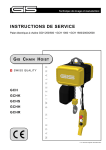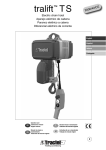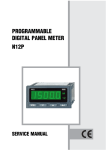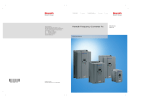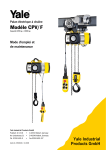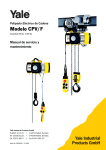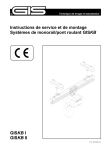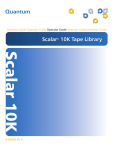Download USER'S MANUAL
Transcript
USER’S MANUAL Electric chain hoists LH 250/500/1000/2000/2500 BVG-D8 BVG-D8+ BVG-C1 Highest Quality Lifting Technology Vers.03 – Released on 11.06.2014 1 Table of contents 0 General information ............................................................................ 4 0.1 0.1.1 0.2 0.2.1 0.3 0.4 0.4.1 0.4.2 0.5 0.5.1 0.5.2 0.5.3 0.6 0.6.1 General safety information ............................................................................................ 4 Safety and hazard precautions ...................................................................................... 4 General safety specifications and procedures ............................................................... 4 Warning paint / Marking / Danger signs ......................................................................... 4 Special safety directions ................................................................................................ 4 Notes on hazard protection ........................................................................................... 5 Hazards caused by mechanical influences .................................................................... 5 Hazards caused by electrical energy / power supply ..................................................... 5 Technical status ............................................................................................................. 6 Technical data ............................................................................................................... 6 Recurrent checks .......................................................................................................... 6 Warranty........................................................................................................................ 7 Operational parameters ................................................................................................. 7 Directions for using the instruction manual .................................................................... 7 1 Description .......................................................................................... 8 1.1 1.2 Operating conditions ..................................................................................................... 8 General description ....................................................................................................... 9 2 Start-up .............................................................................................. 11 2.1 2.2 2.2.1 2.2.2 2.2.3 2.2.4 Transport and assembly ...............................................................................................11 Connection ...................................................................................................................11 Electrical connection ....................................................................................................11 Load chain .................................................................................................................. 12 Limit switch ................................................................................................................. 14 Chain bucket ............................................................................................................... 15 3 Service and maintenance................................................................. 15 3.1 3.2 3.2.1 3.2.2 3.2.3 3.2.4 3.2.5 3.2.6 3.2.7 3.2.8 3.3 General regulations for service and maintenance work................................................ 15 Service and maintenance ............................................................................................ 16 Maintenance overview ................................................................................................. 16 Service overview ......................................................................................................... 16 Brake system .............................................................................................................. 16 Load chain .................................................................................................................. 17 Limit stop assembly ..................................................................................................... 17 Gearbox ...................................................................................................................... 17 Slip clutch.................................................................................................................... 17 Suspension parts......................................................................................................... 18 Ordering spare parts ................................................................................................... 18 4 Measures for obtaining a safe period of operation ....................... 18 4.1 4.2 Determining the actual utilization period S ................................................................... 18 General overhaul ......................................................................................................... 18 5 Appendix............................................................................................ 19 5.1 5.2 5.3 Technical data ............................................................................................................. 19 EC Declaration of conformity ....................................................................................... 21 EC Declaration of incorporation ................................................................................... 22 2 Spare parts / Ordering spare parts The correct order numbers for original spare parts can be obtained from the relevant spare parts list. Please ensure that you have the following data on your chain hoist to hand. This will enable the correct spare parts to be supplied without delay. Electric chain hoist type : ................................................................................................................ Manufacture number : ................................................................................................................ Year of manufacture : ................................................................................................................ Load capacity : ................................................................................................................ Original spare parts for the electric chain hoist can be acquired from the following address: Manufacturer LITEC Italia spa Via Martin Luther King, 70 31032 Casale sul Sile (TV), Italy Tel. +39 0422.997300 Fax +39 0422.997399 [email protected] www.litectruss.com 3 0 General information The following symbols and terms are used in this instruction manual for safety and hazard instructions: 0.1 General safety information DANGER ! Non-compliance, either in part or full, with operating instructions marked with this symbol can result in serious personal injury or even death. Danger notices must be strictly complied with. 0.1.1 Safety and hazard precautions CAUTION ! Non-compliance, either in part or full, with operating instructions marked with this symbol can result in major damage to machinery, property or material. Cautionary notices must be strictly adhered to. NOTE Following the instructions marked by this symbol will lead to more effective and straightforward operation. "Note" directions make work easier. The instruction manual for the electric chain hoist must always be available within the operating area of the hoist. The instructions mentioned in this manual must be strictly adhered to. Furthermore, supplementary to the instruction manual, the statutory regulations governing general accident prevention and environmental protection are to be enforced. Operating and service personnel must have read and understood the operating instructions, in particular the safety instructions, before commencing work. Protective equipment must be made available for operating and service personnel and worn at all times. The operator or his representative is responsible for supervising operating personnel and ensuring they are aware of the hazards and safety implications of working with the electric hoist. 0.2 General safety specifications and procedures − ............................................... Lubricate chain figure 0-1 − ............................................... CE symbol figure 0-2 − ............................................... Model plate figure 0-3 − ............................................... Data plate figure 0-4 − ............................................... Voltage figure 0-5 0.2.1 Warning paint / Marking / Danger signs Figure 0-1 Figure 0-2 0.3 Special safety directions Figure 0-3 Figure 0-4 Figure 0-5 Transport and assembly: − Electric chain hoists, single parts and large components should be carefully affixed to suitable and technically acceptable hoisting apparatus / load lifting members − Connection: − Connection work is only to be performed by personnel specifically designated and trained for the job − Start-up / operation: − Before initial start-up, as well as daily start-up, carry out a visual check and carry out the predefined user-checks routine − Only operate the electric chain hoist if the protective and safety equipment provided is ready and working − Damage to the electric chain hoist and changes in its operational characteristics must be reported immediately to the person responsible − After use, or when in a non-operational mode, the chain hoist should be secured against unauthorised and unintentional use − Refrain from hazardous procedures − See also operational parameters (chapter 0.6) 4 Cleaning / service / repair / maintenance / refitting: − Use the working platforms and ladders provided for assembly work above body height − Do not use machine parts for this purpose − Check electrical cables for damage or wear − Ensure any oils or other agents used are discharged, collected and disposed of safely and in an environmentally sound manner − Reassemble and check safety apparatus that has been disassembled for servicing or repairing the hoist once service and repair work has been completed − Adhere to predefined testing and service intervals specified in the instruction manual − Follow the directions in the instruction manual regarding exchanging parts − Operating personnel should be informed before commencing special or refitting work − Secure the repair working area − Prevent the electric chain hoist from being inadvertently switched on during service or repair work − Erect warning signs − Disconnect the power cable and ensure it cannot be inadvertently switched on again − Retighten screw connections that have been loosened for repair or service work − Replace parts that are not reusable, such as O-rings, gaskets, self-locking nuts, split-pins and washers − Shut down / storage: − Clean and preserve (lubricate/grease) the chain hoist before long periods of inactivity or storage Hazardous areas must be clearly marked by warning signs and cordoned off. It must be ensured that warnings regarding hazardous areas are given due attention. 0.4 Notes on hazard protection 0.4.1 Hazards caused by mechanical influences Hazards can stem from: − incorrect application − not following safety directions properly − not carrying out test and service work thoroughly Physical injury: DANGER ! Unconsciousness and injury through: − crushing, shearing, cutting and twisting − drawing in, ramming, piercing and rubbing − slipping, stumbling and falling Causes: − crush, shear and twist area − parts rupturing or bursting Safety options: − keep floor, equipment and machinery clean − eliminate leakages − observe the required safety distance 0.4.2 Hazards caused by electrical energy / power supply Work on electrical apparatus or machinery may only be performed by qualified electricians or persons under the supervision and guidance of qualified electricians, in accordance with predefined electro-technical regulations. Physical injury: DANGER ! Death from electrical shock, injury and burns through: − contact − faulty insulation − faulty servicing or repair work − short circuit 5 Causes: − contact with, touching or standing too close to uninsulated power and voltage supply terminals − use of uninsulated tools − exposed electricity supply terminals following insulation failure − inadequate safety checks following repair work − incorrect fusing Safety options: − isolate machinery and equipment designated for repair or service work before commencing such work − first check isolated parts for voltage − regularly check electrical fittings − replace loose or damaged cables immediately − always replace blown fuses with fuses of the correct value − avoid contact with or touching live terminals − only use insulated tools 0.5 Technical status The present document was written in 2012. It corresponds to directive 2006/42/EC of the European Parliament and of the Council of 17 May 2006. 0.5.1 Technical data Models D8 Models D8 Plus Models C1 table 0-8, page 4 table 0-9, page 5 table 0-10, page 6 The LITEC hoist models are designed with a shock factor of 1.40 in operation, in accordance with DIN EN 818-7.Incidents investigated by the Employers Liability Insurance Association generate lower shock factors than those occurring in normal operation. 0.5.2 Recurrent checks Each device/ unit operator should adequately note all checks, maintenance and inspections performed in the log book, and have these confirmed by the competent person in charge. Incorrect or missing entries will lead to forfeiture of the manufacturer's warranty. CAUTION ! Equipment and cranes should be periodically tested by an expert. Basically, visual and functional checks should be performed to determine the condition of components as regards damage, wear, corrosion or other modifications. In addition, safety equipment is assessed for completeness and efficiency. It may be necessary to dismantle the equipment under inspection to correctly assess expendable parts. CAUTION ! Suspension apparatus must be inspected over its entire length, including covered or hidden parts. CAUTION ! All periodical inspections should be arranged by the operator. 6 0.5.3 Warranty − the warranty is void if the installation, operation, testing or maintenance is not carried out according to these instructions − troubleshooting and repair under warranty may only be carried out by qualified persons and only after consultation and agreement with the manufacturer / supplier. Any modifications to the product or the use of non-original replacement parts will void the warranty. 0.6 Operational parameters Electric chain hoists of the series LH are hoists of differing load capacities. They can be installed as stationary or mobile units. Electric chain hoists are manufactured in accordance with the latest technical developments and recognised safety standards, and are tested for safe operation by the manufacturer. Electric chain hoists are approved by various international institutes such as BG and others. Electric chain hoists of the above series may only be used when in an acceptable technical condition, in accordance with their operating parameters, by trained personnel in a safe and responsible manner. The operational parameters of the electric chain hoist also encompass compliance with the pre-defined operating, service and maintenance requirements laid down by the manufacturer. The operational parameters do not include: − exceeding the defined load capacity − pulling the load diagonally − heaving, pulling or dragging the load − standing under suspended loads (see di) − transporting excessive loads − pulling on the control cable − failing to observe the load hook constantly − running the chain over edges − failing to observe the load constantly − allowing the load to fall due to a slack chain − use at temperatures below -10° C or above +40° C − use in an explosive environment See also table 0.6 for: − transporting persons − transporting loads when personnel are underneath The LH series of electric chain hoists are intended for use in setting up events. Events include such items as concerts, shows, conferences, meetings, exhibitions, presentations, demonstrations, film or television shoots and similar. The location of such events include, amongst other places, theatres, multipurpose halls, studios, film sets, television and radio broadcasting, concert halls, conference centres, schools, exhibitions, fairs, museums, discotheques, vaudeville, recreational parks, sports facilities, open air theatres and meetings. This standard differentiates between three types of electric chain hoists: D8 Hoist Electric chain hoist according to BGV D8/GUV-V D8 (previously GUV 4.2) "Winches, lifting and pulling devices" for use as a chain hoist for lifting loads in construction. D8 Plus Hoist Electric chain hoist based on BGV D8/GUV-V D8 (previously GUV 4.2) "Winches, lifting and pulling devices" for use as a chain hoist for lifting loads in construction with the special characteristic of being able to hold loads statically above personnel, without the use of secondary safety devices. C1 Hoist (scenery hoist) Electric chain hoist according to BGV C1/ GUV-V C1 (previously GUV 6.15) "Staging and production facilities for the entertainment industry" for holding and moving loads above personnel. The types of electric chain hoists specified above can be operated both individually and in groups. 7 Electric chain hoists are offered in a multiplicity of designs and feature options, as well as with different safety devices. This means that the choice of chain hoist is extremely important. Here consideration must be given to risks arising from the nature of the operational use and the specific operating conditions. The choice of the type of electric chain hoist depends on the operating conditions: D8 with secondary safety device D8 D8 Plus C1 Where personnel are under the load Erection / dismantling, rigging operations Holding loads Scene movement not permitted not permitted not permitted not permitted not permitted permitted permitted permitted permitted not permitted not permitted permitted Where equipment is permanently installed in locations where events take place, electric chain hoists according to BGV C1/GUV-V C1 should be provided, on account of the mode of operation and the anticipated risks. Inching operations, ground mooring and driving against the limit switches should be avoided. The manufacturer accepts no responsibility for damage to equipment and third parties ensuing from such action. 0.6.1 Directions for using the instruction manual This instruction manual includes the following chapters: 0 1 2 3 General information Description Start-up Service and maintenance 4 5 Measures for obtaining a safe period of operation Appendix Supplementary to the instruction manual, the following documentation from the operator must be noted: − Declaration of conformity − Log book − Spare parts list(s) − Circuit diagrams Page and figure numeration: The pages are consecutively numbered. Blank pages are not numbered, however are calculated together with the consecutive pages. Figures are numbered consecutively by chapter. 8 1 Description The ambient temperature must be between -10° C and +40° C. When the equipment is commissioned, and periodically thereafter, the functionality of both brakes must be examined. The periodic examination should be carried out by competent personnel annually and by an expert every four years. The verifiability of the individual brakes is to be provided by a control engineer. A sample control scheme for a D8 Plus hoist or a sample guide for the PLC used in a C1 hoist can be obtained from LITEC Italia spa. 1.1 Operating conditions Classification according to application requirements: Electric chain hoists and travelling gears are classified according to the following regulations into ISO Groups: − − − − − DIN EN 14492-2 DIN 15400 (load hook) FEM calculation regulations for series lifting equipment (chain drive, motor, full load-life span) ISO 4301-1: D (M3) = 400 h Remarks about general revision (see chapter 4) There is differing coefficient data for the ISO Groups that must be adhered to in operation. CAUTION ! The travelling gear is always classified as the same ISO Group as the corresponding electric chain hoist. NOTE The ISO Group registration number of the electric chain hoist can be found on the data plate. The manufacturer will only guarantee the safety and lasting operation of the electric chain hoist when used for applications that fall within its valid ISO Group coefficient data. Before the first start-up, the user must estimate according to the features in table 1-1, which of the four types of load is applicable to the use of the electric chain hoist during its whole service life. Table 1-2 shows standard values for the operating conditions of the ISO Groups depending on the type of load and the time of operation. CAUTION ! Before starting up the electric chain hoist for the first time, it must be determined with which of the load types shown in table 1-1 the electric chain hoist is to operate. Assignment to a load type or a load collective (k) applies for the entire operational life of the equipment and may not be altered for operational safety reasons. Example 1: Ascertaining permissible running time of the electric chain hoist: An electric chain hoist of the ISO Group M4 is to be used for medium stress load tasks throughout its entire service life. This corresponds to load type <3 heavy> (see table 1-1). According to the values in table 1-2, the electric chain hoist should not be used for longer than 0.5 - 1 hour per working day. Example 2: Ascertaining permissible load type: An electric chain hoist of the ISO Group M5 is to be used for approximately 6 hours per working day, throughout its complete service life. Consequently the electric chain hoist should be operated in accordance with the characteristics of the load type <1 light> (see table 1-1). 9 Load type 2 medium 0.50 < k < 0.63 k = 0.63 Load type 3 heavy 0.63 < k < 0.80 k = 0.80 Load type 4 very heavy 0.80 < k < 1.00 k = 1.00 % of bearing capacity % of bearing capacity % of bearing capacity Table 1-2 Operating conditions Load type 1 light k < 0.50 k = 0.50 % of bearing capacity Table 1-1 Load collectives % of running time Full load by way of an exception, however, predominantly low loads % of running time Frequently fully loaded, however continuously lightly loaded % of running time Frequently fully loaded, continuous average loading % of running time Regularly fully loaded ISO Group according to ISO 4301-1 Load collective M3 M4 M5 M6 M7 Average running time per working day [h] 1 - light k < 0.50 up to 2 2-4 4-8 8 - 16 over 16 2 - medium 0.50 < k < 0.63 up to 1 1-2 2-4 4-8 8 - 16 3 - heavy 0.63 < k < 0.80 up to 0.5 0.5 1 1-2 2-4 4-8 4 - very heavy 0.80 < k < 1.00 up to 0.25 up to 0.5 0.5 1 1-2 2-4 k = Load collective (type of load) 1.2 General description Figure 1-1 1 Housing 2 Motor and brake 3 Rotor shaft with integrated slip clutch 4 Limit switch 5 Electrical controller 6 Chain drive 7 Gearbox The electric chain hoist meets the requirements of the EC Machinery Directive and the relevant EN and FEM standards. Housing and cover are made of a sturdy aluminum die casting. Fins on the motor ensure optimum cooling. The chain box can be attached to the compactly constructed housing. A drilled hole is provided for both the power supply cable gland and the control cable. The lugs, or optionally the suspension hooks, are attached to the flange ring. GIS electric chain hoists are driven by asynchronous motors. For two-speed models a pole switching version of the motor is fitted. The braking system consists of a DC-operated spring loaded brake. When there is no current, the pressure spring generates the braking torque. For functional reasons, the slip clutch is installed in front of the brake system and integrated into the rotor shaft. It protects the hoist from overload and takes on the function of an emergency end stop for the highest and lowest hook positions. A gear-type limit switch is fitted to limit the highest and lowest hook position. As an option, emergency stop contacts with positive separation can be retrofitted downstream. Electric chain hoists are fitted with a 42 V contactor control as standard. The emergency stop contactor that is usually installed separates all three mains power phases when the red button is pressed. The high-strength round steel chain meets the requirements of grade DAT (8SS) to DIN EN 818-7. Sprocket and pulley are hardened. The load hook, which complies with DIN 15400, is fitted with a safety latch. The two-or three-stage, closed spur gear units are usually helically cut. The gears are mounted on roller bearings and run greased. The standard equipment fitted to the electric chain hoist includes a control switch (up/ down with emergency stop). 10 DANGER ! Mechanical adjustments may only be performed by authorised specialists. 2 Start-up CAUTION ! Operating staff must carefully read the operating instructions of the electric chain hoists before its initial operation and carry out all checks. Only when safe operation has been established may the device be put into operation. Unauthorised persons may not operate the device or carry out work with it. 2.1 Transport and assembly The safety directions for handling with loads should be followed (see chapter 0.3) when transporting and assembling the electric chain hoist. Electric chain hoists must be assembled by qualified staff, always bearing in mind the accident prevention directions in chapter 0.2. Before assembly the electric chain hoist must be stored in an enclosed room or covered area. Should the electric chain hoist be destined for operation outdoors, then it is recommended that a protection cover is erected to shield it from the effects of the weather. Wherever possible, the electric chain hoist should be transported in its original packaging. The goods delivered should be checked for completeness and the packaging disposed of in an environmentally sound manner. It is recommended that the electric chain hoist is assembled and connected on-site by our qualified customer service personnel. 2.2 Connection Check the identification plate as to whether the chain hoist corresponds to the type ordered (D8, D8 Plus, C1). 2.2.1 Electrical connection The chain hoist must display the following markings: D8…………..: Triangle D8 Plus…….: Square C1…………..: Circle The appropriate electrical diagram can be found in the cover of the electric chain hoist. In the case of the D8 Plus and C1 chain hoists, once the device is in position the power must be disconnected using a lockable switch. To commission the mechanically tested chain hoist as a C1 hoist, the control system and the electrical assessment of the load measuring device must likewise be approved by a certified inspection body as a C1 system (in accordance with BGV C1/GUV-V C1). The principles laid out in BGG 912/GUV G 912 are to be used. An inspection and test log book is to be set up, consisting of the equipment documentation provided by the manufacturer and the test reports. Plans and descriptions of the electrical system are to be supplemented by the appropriate control engineer on a project-specific basis. DANGER ! Electro-technical adjustments may only be performed by authorised specialists. The mains connection cable, the mains connection fuse and the main switch for connecting the electric chain hoist to the mains power supply must be installed beforehand by the customer. A 4-wire cable with a PE protective conductor is needed to provide the power supply for three-phase models. A 3-wire cable with a protective conductor is adequate for singlephase models. The length and cross-section must be appropriate for the power consumption of the electric chain hoist. − Before connecting the electric chain hoist, check whether the operating voltage and − − − − frequency that are specified on the name plate correspond to the available power supply Remove cover on electrical side Insert connecting cable with M25 x 1.5 screwed cable connection into hole at side and connect to terminals L1, L2, L3 and PE in accordance with supplied circuit diagram (see figure 2-1) Insert control cable with M20 x 1.5 screwed cable connection through hole in underside of housing and connect to terminals 1, 2, 3, 4 and 10 (see figure 2-2) Attach strain relief to housing (see figure 2-3) CAUTION ! The control switch must be attached to the strain relief cord and not to the cable. 11 Figure 2-1 Figure 2-2 Figure 2-3 Not Aus 2.2.2 Load chain CAUTION ! − Only use original chains − Welded seam of the chain links must face inward on the chain wheel (see figure 2-5) − The gearbox limit switch must be mechanically disabled in order to pull in the chain, see chapter 2.2.3 2.2.2. Load chain Before start-up and during operation the load chain must be oiled along its full length. Oil must constantly be present on the internal, contacting and rubbing surfaces of the chain links. Lubrication is carried out by submersion or with an oil can, using a creeping gear oil. The end of the chain should be attached to a flexible piece of wire (1) and fed through the chain wheel (2) of the electric chain hoist. Through short switching impulses, the chain (3) will be housed correctly in accordance with figure 2-5. The lifting height must be adjusted such that the hook fittings lie on the ground in the lowest hook position. Figure 2-5 Single fall operation: The load hook (1) is connected to the chain using a shim (2). Bolt (3) installation is important for power transmission (see figure 2-6). CAUTION ! Pay attention to correct arrangement of suspension (see figure 2-7)! Grease the bearings thoroughly. Figure 2-6 12 Double fall operation: Connect load side of chain end to chain retainer (3) and fix in housing guide rail. Assemble bottom sheave (1) with load hook (2) in accordance with figure 2-9. CAUTION ! Pay attention to correct arrangement of suspension (see figure 2-10)! Do not twist chain lengthwise (see figure 2-8)! Grease the bearings thoroughly. Chain end: The chain end must be attached to the housing in accordance with figure 211. The section of chain after the end stop (1) must be adjusted to the height of the chain bucket. The length of the section of chain must be selected so that the end stop lies on the floor of the magazine when the chain runs into it (see figure 2-11). Figure 2-9 Figure 2-11 13 2.2.3 Limit switch The electric chain hoist is equipped with a gearbox limit switch as standard. This is also suitable for normal limit switch operation with a high degree of accuracy. The operation of the limit switches (highest and lowest hook position) must be checked during start-up. Three different transmissions are available that are adapted to the lift: GCH 250/500 Transmission i = 1:1 i = 1:3 i = 1:6 Colour black yellow blue Single fall lift [m] 20 60 120 Double fall lift [m] 10 30 60 GCH 1000 Transmission i = 1:1 i = 1:3 i = 1:6 Colour black yellow blue Single fall lift [m] 30 80 180 Double fall lift [m] 15 40 90 GCH 1600/2000/2500 Transmission i = 1:1 i = 1:3 i = 1:6 Colour black yellow blue Single fall lift [m] 36 110 220 Double fall lift [m] 18 55 110 Description of settings (see figure 2-12): − Before pulling in the chain or changing the chain, the gearbox limit switch must be mechanically disabled by securing the rocker (1) − Pull in the chain − Move to highest hook position, rotate red ratchet wheel (front) (2) to switching cam of top limit switch (3); (rotate clockwise for higher hook position and anticlockwise for lower hook position) − Activate rocker, move to lowest hook position, rotate green switching wheel (rear) (4) to switching cam of bottom limit switch (5); (rotate anticlockwise for higher hook position and clockwise for lower hook position) − Activate rocker (must engage in switch wheel) − Check operation of limit switch; the end stop and the hook fittings must not touch the housing Figure 2-12 14 2.2.4 Chain bucket − Move chain out at load side until limit switch is activated − Attach chain bucket and allow chain to run in (see figure 2-13) − Attach free end of chain to housing (see chapter 2.2.2) DANGER ! All steel plate chain buckets must be equipped with an additional wire cable with a minimum diameter of 2 mm (see figure 2-14). Figure 2-13 Figure 2-14 Figure 2-14 15 3 Service and maintenance 3.1 General regulations for service and maintenance work Operating failures in electric chain hoists affecting the safe operation of the device should be remedied immediately. CAUTION ! Maintenance and repair work on the electric chain hoist may only be carried out by qualified and trained personnel. CAUTION ! If the operator performs maintenance work on an electric chain hoist on his own account, the type of maintenance performed together with the date carried out must be entered in the log book. Alterations to, as well as modifications and supplements to electric chain hoists which may affect safety must be authorized by the manufacturer in advance. Structural alterations to chain hoists not authorized by the manufacturer exempt the manufacturer from liability in case of damage. Material warranty claims will only be recognized if solely manufacturer’s genuine spare parts have been used. We explicitly wish to point out that those original parts and accessories not supplied on our behalf cannot be inspected or released by us. General: Service and maintenance are preventive measures designed to preserve the full functionality of electric chain hoists. Non-compliance with service and maintenance routines can result in reduction in the useful function of and/ or damage to electric chain hoists. Service and maintenance work should be carried out at the predefined time intervals, in accordance with the instruction manual (table 3-1 and 3-2). During service and maintenance work, general accident prevention directions, special safety directions (chapter 0.3) as well as hazard protection instructions (chapter 0.4) should be followed. DANGER ! Service and maintenance work should only be performed on unloaded electric chain hoists. The main switch must be off. The lower sheave or hook fittings must be lying on the floor or a maintenance platform. Maintenance work encompasses visual checks and cleaning routines. Service work includes additional functional checks. During the functional checks, all securing elements and cable clamps must be checked for secure seating. Cables must be inspected for dirt, discoloration and arc spots. CAUTION ! Used operating materials (oil, lubricants, etc.) should be safely collected and disposed of in an environmentally friendly manner. Service and maintenance intervals are defined as follows: t : ..... daily 3M : quarterly 12 M : annually The predefined service and maintenance intervals should be reduced when the loading of the electric chain hoist is exceptionally large and when frequently operated in adverse conditions (dust, heat, humidity, steam, etc.). 16 3.2 Service and maintenance 3.2.1 Maintenance overview See table 3-1. Table 3-1 Maintenance overview Term t Activity Notes 1. Load chain X visual check clean and lubricate as needed see chapter 2.2.2 2. Hoist and carriage X abnormal noise check seal check 3. Power supply cable X visual check 4. Limit switch X 5. Seal 3M 12 M function check X 6. Cable discharging device control cable see chapter 2.2.3 visual check X visual check 3.2.2 Service overview See table 3-2. Table 3-2 Service overview Term t 1. Load chain 3M 12 M Activity Notes see chapter 2.2.2 / 3.2.4 X lubricate measure wear see chapter 3.2.3 X 2. Brake system X function check with load 3. Electrical fittings X X function check 4. Securing screws on suspended parts and load hook with accessories X check for cracks check screw movement see chapter 3.2.8 5. Gearing X visual check wear see chapter 3.2.6 6. Limit switch X check switching elements see chapter 2.2.3 7. Slip clutch X function check see chapter 3.2.7 The spring-loaded brake is a solenoid operated single disk brake with two friction surfaces. The braking force is applied by compression springs. The braking torque is generated when no current is applied. The ventilation is electromagnetic. The brake operates with DC current. The brake must be able to hold the nominal load in power free mode without any problems. 3.2.3 Brake system CAUTION ! The brake coil voltage must be the same as the operating voltage. NOTE The brake has no air gap adjustment. If the air gap (a max., table 3-3 and figure 3-1) reaches maximal value, the brake pad needs changing. Table 3-3 Air gap Figure 3-1 GCH 250/500 GCH 1000 GCH 1600/2000/2500 Air gap (a) [mm] +0.15 0.4 0 +0.2 0.5 0 +0.2 0.5 0 Air gap (a max.) [mm] 0.7 0.9 0.9 Torque value [Nm] 3 10 10 17 3.2.4 Load chain The load chain should be periodically checked for abrasion. The check is based upon three measurements: see accepted wear factors (table 3-4) and measurement points (figure 3-2). CAUTION ! The chain should be replaced when the measurements exceed or fall short of those defined in the table. The chain wheel and chain guide should be checked for wear at the same time and, where necessary, be replaced. Only use original chains. The chain links should not be welded. The new chain is installed in accordance with chapter 2.2.2. NOTE For ease of installation, the old chain and new chain can be connected by a piece of flexible wire. Table 3-4 Wear factors load chain Figure 3-2 GCH 250 GCH 500 GCH 1000 GCH 1600 GCH 2000/2500 Chain type d x t [mm] 4 x 12.3 5 x 15.3 7 x 22 9 x 27 10 x 28 Tolerances in accordance with: DIN 685, part 5 DIN EN 818-7 1. Measurement over 11 chain links; a = 11t [mm] 138.0 171.6 246.8 302.9 314.2 2. Measurement over 1 chain link 1t [mm] 12.9 16.0 23.1 28.35 29.4 [mm] 3.6 4.5 6.3 8.1 9.0 3. Measurement of the chain link diameter d1 + d2 dm = 2 ; (dm min. = 0.9 x d) 3.2.5 Limit stop assembly CAUTION ! A damaged buffer plate, underneath the housing, must be replaced. Screw connections at the limit stop and shims or lower sheaves should be checked and, where necessary, tightened to the right torque. For coefficient data see chapter 3.2.8. 3.2.6 Gearbox The gearing has continual lubrication. Lubricant ....................... : Strub N1424 Can be mixed and is compatible with all other similar brand name grease (DIN 51502: GP OM-20) Lubricant quantity .......... : GCH 250/500 ................. : 0.4 kg GCH 1000...................... : 1.0 kg GCH 1600/2000/2500 .... : 1.8 kg 3.2.7 Slip clutch The slip clutch is set at 125% at the factory and can be relied on to prevent the chain hoist from being overloaded (the force limiting factor according to DIN EN 14492-2 is ΦDAL = 1.4). The coating is wear resistant. CAUTION ! Adjustment and testing of the slip clutch may only be carried out by authorized personnel and must be recorded in the log book. 18 All statically loaded parts are considered suspension parts. The bearing surfaces of the slewing suspension parts must be periodically greased. Torque values for screws of property class 8.8 according to DIN ISO 898: 3.2.8 Suspension parts M5 6 Nm M6 10 Nm M8 24 Nm M 10 48 Nm M 12 83 Nm 3.3 Ordering spare parts Information on how to order spare parts can be found on page 3. The appropriate assembly diagram is considered to be a supplement to the parts catalogue. 4 Measures for obtaining a safe period of operation The statutory and health requirements of the EU regulations stipulate that specific dangers which may arise from fatigue or ageing must be prevented. Accordingly, operators of standard hoist gear are obliged to determine the actual utilization. The actual utilization period is determined and recorded as part of the annual inspection by customer service engineers. A general overhaul must be carried out when the theoretical utilization limit is reached, or after no more than 10 years. All checking and the general overhaul itself must be arranged by the operator of the hoist gear. The following theoretical utilization periods apply to electric chain hoists that are categorized according to ISO 4301-1 (converted into full-load hours): M3 400 h M4 800 h M5 1600 h M6 3200 h M7 6300 h The actual utilization period depends on the daily operating time and the load collective. Running time is determined from information provided by the operator or recorded using a meter that counts the number of operating hours. The load collective is determined in accordance with table 1-1, page 9. These two items of information are used to calculate the annual utilization period from table 4-1. If an operating data acquisition system (BDE) is used, the actual utilization can be read out directly by our experts during the annual inspection. 4.1 Determining the actual utilization period S CAUTION ! The values periodically calculated or read-off must be recorded in the log book. On reaching the theoretical service life (no later than 10 years for recording without BDE), a general overhaul should be performed. This enables the equipment to continue operating safely for a further period of utilization (service life). Components must be inspected and/ or replaced in this overhaul according to table 4-2. Inspection and approval for further use must be performed either by a specialist company authorized by the manufacturer, or by the manufacturer personally. The inspector determines: – the new theoretical utilization possible – the maximum period until the next general overhaul 4.2 General overhaul This data should be recorded in the log book. Table 4-1 Annual service life Utilization per day [h] Table 4-2 General overhaul <= 0.25 <= 0.50 (0.16) (0.32) <= 1.0 (0.64) Load collective <= 2.0 (1.28) <= 4.0 (2.56) <= 8.0 (5.12) <= 16.0 (10.24) > 16.0 (20.48) Annual service life [h] k = 0.50 6 12 24 48 96 192 384 768 k = 0.63 12 24 48 96 192 384 768 1536 k = 0.80 24 48 96 192 384 768 1536 3072 k = 1.00 48 96 192 384 768 1536 3072 6144 Components of GCH-models all types Brake Motor shaft Gear teeth Antifriction bearing Washers Chain Chain wheel, chain guide Deflection wheels Suspension Load hook Travelling gear, running wheel Contactor, limit switch * replace when worn Check for wear * Replace x x x x x x ** x x x x x x ** replace no later than at general overhaul 19 5 Appendix Table 0-8 D8 technical data Term Dead weight M3 (1Bm) 150 s/h, 25% duty 1 fall load normal hoist 250/1NL D8 500/1NL D8 1000/1NL D8 2000/1NL D8 2000/1NL D8 Table 0-9 Term LCH 1000/1NL D8 Plus LCH 2000/1NL D8 Plus Table 0-10 Term 1 fall tot. load climbing hoist M4 (1Am) 180 s/h, 30% duty 1 fall load normal hoist 1 fall all. load climbing hoist 1 fall tot. load climbing hoist Chain safety Chain safety factor factor use as normal use climbing hoist M5 (2m) 240 s/h, 40% duty 1 fall load normal hoist 1 fall all. load climbing hoist 1 fall tot. load climbing hoist Chain safety Chain safety factor factor use as normal use climbing hoist M6 (3m) 300 s/h, 50% duty 1 fall load normal hoist 1 fall all. load climbing hoist 1 fall tot. load climbing hoist Chain safety Chain safety factor factor use as normal use climbing hoist Lifting speed 1 fall [kg] [kg] [kg] [kg] [kg] [kg] [kg] [kg] [kg] [kg] [kg] [kg] [kg] 25 250 225 250 8.20 8.20 200 175 200 10.25 10.25 160 135 160 12.81 12.81 125 100 125 16.40 16.40 4 30 500 470 500 6.40 6.40 400 370 400 8.01 8.01 320 290 320 10.01 10.01 250 220 250 12.81 12.81 4 50 1000 950 1000 6.28 6.28 800 750 800 7.85 7.85 630 580 630 9.96 9.96 500 450 500 12.55 12.55 4 80 2000 1920 2000 6.40 6.40 1600 1520 1600 8.01 8.01 1250 1170 1250 10.25 10.25 1000 920 1000 12.81 12.81 4 80 2000 1920 2000 6.40 6.40 1600 1520 1600 8.01 8.01 1250 1170 1250 10.25 10.25 1000 920 1000 12.81 12.81 8 [m/min] Chain safety factor normal use Chain safety factor use as climbing hoist Chain safety factor normal use Chain safety factor use as climbing hoist Lifting speed D8 technical data Dead weight M3 (1Bm) 150 s/h, 25% duty Chain safety factor normal use 1 fall load normal hoist 1 fall all. load climbing hoist 1 fall tot. load climbing hoist [kg] [kg] [kg] [kg] 50 500 450 500 12.55 80 1000 920 1000 12.81 Chain safety factor use as climbing hoist M4 (1Am) 180 s/h, 30% duty Chain safety factor normal use 1 fall load normal hoist 1 fall all. load climbing hoist 1 fall tot. load climbing hoist [kg] [kg] [kg] 12.55 500 450 500 12.55 12.81 1000 920 1000 12.81 Chain safety factor use as climbing hoist M5 (2m) 240 s/h, 40% duty 1 fall load normal hoist 1 fall all. load climbing hoist 1 fall tot. load climbing hoist [kg] [kg] [kg] 12.55 500 450 500 12.55 12.81 1000 920 1000 12.81 M6 (3m) 300 s/h, 50% duty 1 fall 1 fall load normal hoist 1 fall all. load climbing hoist 1 fall tot. load climbing hoist [kg] [kg] [kg] 12.55 500 450 500 12.55 12.55 4 12.81 1000 920 1000 12.81 12.81 4 [m/min] D8 technical data Dead weight M3 (1Bm) 150 s/h, 25% duty 1 fall load normal hoist 500/1NL C1 1000/1NL C1 2000/1NL C1 1 fall all. load climbing hoist Chain safety Chain safety factor factor use as normal use climbing hoist 1 fall all. load climbing hoist 1 fall tot. load climbing hoist Chain Chain safety safety factor factor use as normal use climbing hoist M4 (1Am) 180 s/h, 30% duty 1 fall load normal hoist 1 fall all. load climbing hoist 1 fall tot. load climbing hoist [kg] [kg] 220 250 12.81 12.81 [kg] [kg] [kg] 30 250 220 250 50 500 450 500 12.55 12.55 500 450 500 12.55 80 1000 920 1000 12.81 12.81 1000 920 1000 12.81 12.81 [kg] Chain safety factor use as climbing hoist [kg] 12.81 250 Chain safety factor normal use M5 (2m) 240 s/h, 40% duty 1 fall load normal hoist 1 fall all. load climbing hoist 1 fall tot. load climbing hoist Chain safety factor normal use Chain safety factor use as climbing hoist [kg] [kg] [kg] 250 220 250 12.81 12.81 12.55 500 450 500 12.55 12.81 1000 920 1000 12.81 M6 (3m) 300 s/h, 50% duty 1 fall load normal hoist 1 fall all. load climbing hoist 1 fall tot. load climbing hoist Chain safety factor normal use Chain safety factor use as climbing hoist Lifting speed 1 fall [kg] [kg] [kg] 250 220 250 12.81 12.81 [m/min] 4 12.55 500 450 500 12.55 12.55 4 12.81 1000 920 1000 12.81 12.81 4 20 EC DECLARATION OF CONFORMITY Declaration for machinery according to EU directives 2006/42/EC, Annex II A, 2004/108/EC, Annex I and 2006/95/EC, Annex III We, GIS AG, Hebe- und Fördertechnik, Luzernerstrasse 50, CH-6247 Schötz hereby declare that the following machinery GIS electric chain hoist, series payload range GCH 100 kg - 5000 kg developed for lifting and lowering loads, is, in standard production and from the 2005 model year, inclusive of load control, meets the essential requirements of the following EC directives, as applicable to the scope of the delivery: EC Machinery Directive EC Directive on Electromagnetic Compatibility EC Low Voltage Directive 2006/42/EC 2004/108/EC 2006/95/EC Harmonized standards applied: ISO 2374 DIN EN 818-7 DIN EN ISO 13849-1 DIN EN 14492-2 DIN EN 60204-32 Lifting appliances; Range of maximum capacities for basic models Short link chain for lifting purposes; Part 7: Grade T Safety-related parts of control systems; Part 1: General principles for design Cranes, power driven winches and hoists; Part 2: Power driven hoists Electrical equipment of machines; Part 32: Requirements for hoisting machines Standards and technical specifications applied: FEM 9.751 FEM 9.755 DIN 56950 VPLT.SR2.0 Power driven series hoist mechanisms; Safety Measure for achieving safe working periods Entertainment technology Standards to the entertainment technology Authorized to compile relevant technical documentation: Mr. Pius Engel, GIS AG, Luzernerstrasse 50, CH-6247 Schötz. Schötz, 08.11.2012 I. Muri Director GIS AG E. Widmer Sales Manager Responsible for completion, installation and commissioning as per instructions: Place: ……………………………………… Date: ...................................................................................................... Responsible: .............................................................................................................................................................. Company: .................................................................................................................................................................. 21 EC DECLARATION OF INCORPORATION Declaration for the incorporation of partly completed machinery according to EU directives 2006/42/EC, Annex II B, 2004/108/EC, Annex I and 2006/95/EC, Annex III We, GIS AG, Hebe- und Fördertechnik, Luzernerstrasse 50, CH-6247 Schötz hereby declare that the following partly completed machinery GIS electric chain hoist, series payload range GCH 100 kg - 5000 kg developed for lifting and lowering loads, is, in standard production and from the 2005 model year, inclusive of load control, intended for installation in machinery and meets the essential requirements of the following EC directives, as applicable to the scope of the delivery: EC Machinery Directive EC Directive on Electromagnetic Compatibility EC Low Voltage Directive 2006/42/EC 2004/108/EC 2006/95/EC We also declare that the technical documentation has been compiled in accordance with Annex VII, Part B of Directive 2006/42/EC. We undertake to submit the specific documents relating to the lifting mechanism to national authorities on receipt of a reasonable request. The information will be supplied by electronic means. Harmonized standards applied: ISO 2374 DIN EN 818-7 DIN EN ISO 13849-1 DIN EN 14492-2 DIN EN 60204-32 Lifting appliances; Range of maximum capacities for basic models Short link chain for lifting purposes; Part 7: Grade T Safety-related parts of control systems; Part 1: General principles for design Cranes, power driven winches and hoists; Part 2: Power driven hoists Electrical equipment of machines; Part 32: Requirements for hoisting machines Standards and technical specifications applied: FEM 9.751 FEM 9.755 DIN 56950 VPLT.SR2.0 Power driven series hoist mechanisms; Safety Measure for achieving safe working periods Entertainment technology Standards to the entertainment technology This declaration only refers to the lifting mechanism. Commissioning is prohibited until it has been firmly ascertained that the crane, in which the lifting mechanism is installed, complies with the provisions of the above EC directives. Authorized to compile relevant technical documentation: Mr. Pius Engel, GIS AG, Luzernerstrasse 50, CH-6247 Schötz. Schötz, 08.11.2012 GIS AG I. Muri Director E. Widmer Sales Manager Responsible for completion, installation and commissioning as per instructions: Place: ………………………………………. Date: ...................................................................................................... Responsible: .............................................................................................................................................................. Company: .................................................................................................................................................................. 22























